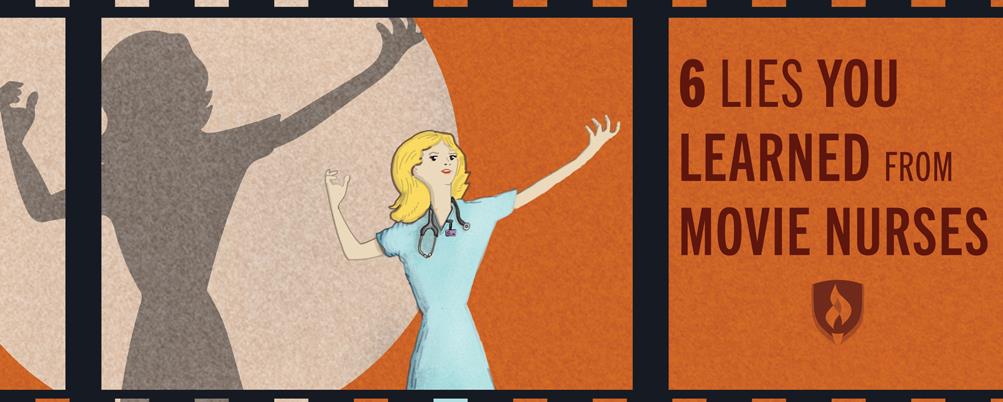
You’re probably familiar with the scene. Inside a hospital, doctors are rushing around with clipboards and white coats, surgeons are operating with furrowed brows and the camera pans to an attractive woman in flawless makeup wearing shoes no medical environment would condone.
Hollywood has its own particular brand of fictionalization for every profession—that’s the show business. But how do movie nurses match up to their real-life counterparts? Are the nurses on the silver screen anything like the real deal?
If you’re a fan of medical TV shows and movies, you might be curious if the portrayal is accurate. We enlisted nursing pros to set the record straight and bust the common myths of movie nurses.
Myth #1: Nurses are assistants to physicians
The stereotypical “scalpel, please” might come to mind when you think of doctors interacting with nurses. But in reality, nurses are on the floor to do important jobs that have nothing to do with waiting around for a doctor to assist.The work of a nurse has its own duties and responsibilities, entirely separate to that of a physician.
“Nurses are more the partners of the doctors,” says Eileen Sollars, RN, ADN. “Our work includes making sure the doctor is meeting the needs of the patient. In movies the nurse is still cast as the handmaiden of the doctor.”
Dr. Colleen Koob, Dean of Nursing at Rasmussen College, says many popular TV shows show the physicians and residents doing everything. This portrayal makes it seem like nurses are simply around for backup, which she says just isn’t the case.
“I couldn’t tell you the last time I saw a physician do a dressing change, give a medication or draw blood,” Koob says, proving you can’t always believe what you see on TV.
Myth #2: Nurses all do the same basic thing
You’re average TV show or movie doesn’t provide much detail about the types of nurses in scene. Even when nurses play primary roles, their work is usually vaguely depicted. In reality, there are countless kinds of nurses in the world of healthcare.
“I find it annoying when shows skip over our important work and just show an actor pushing buttons in the background,” says Nick Angelis, nurse anesthetist and author. He enjoys making sure nurse anesthetists have prominent roles in his own creative work to help illustrate the diversity of work in nursing.
Myth #3: Nurses are flirty women
This is one of the most cliché myths out there; you’d think script writers would give it a wide berth. But there’s something Hollywood can’t resist about an attractive female nurse to amp up the romantic drama in any screenplay.
“In general nurses are portrayed as a sexy or ‘bimbo’ kind of character,” Koob says. That depiction perpetuates the misconception that all nurses are female. Seeing a made-up actress in pumps also undermines the serious hard work and intelligence it takes to be a nurse.
Myth #4: Nurses are entry-level employees
In the same way movies generalize the variety of nursing titles and roles, they also generalize the tiers of advancement nurses climb through. After earning a nursing degree, nurses have many opportunities for lifelong career advancement. That advancement could come in an academic sense, such as acquiring a certification or advancing your nursing degree, or it could come in the form of promotions to management positions or increased responsibilities.
Nurses can advance from unit managers to senior-level roles like director, vice president or chief of nursing, according to the Bureau of Labor Statistics (BLS). Some nurses work towards becoming advance practice registered nurses (APRNs). APRNs prescribe medicine and include nurse anesthetists, nurse midwives, and nurse practitioners.
Myth #5: Nurses are professionally unreliable
“Even when a [TV show] stars nurses, the characters are often written as drug addicted, depressed individuals with messy personal lives,” Koob says.
While this makes for good ratings, it’s a pretty far cry from reality. Koob points out that nurses are always rated at the top of the most trusted professionals list. “We are a caring bunch of professionals whose main focus is advocating for our patients and their families,” she adds.
Myth #6: Nurses work in pristine conditions
Picture a hospital scene in the movie where a patient suddenly flat lines. Nurses and physicians come running to the bedside, reach for the defibrillator and ... it’s dead. Ok, this typically doesn’t happen in the movies, because things always seem to run smoothly. But according to LPN Lauren Chambers, the perfectly organized hospital where every bit of equipment stands ready is a movie fantasy.
“Medication may be missing or the cart just may not be where it is supposed to be,” Chambers explains. “The movies never really show ribs breaking during CPR or messy bowel movements either.” In high intensity situations, there are more variables than just nurse versus the illness.
Chambers acknowledges that being a nurse is a little scarier and messier than you might initially expect, but tells nursing students that when things are going wrong, you’ll rely on your critical thinking skills to get you through. “The best part is when your creative juices begin to flow, and you come up with ideas you never knew you had,” she says.
Going beyond the screen
“Although it's not a realistic portrayal of the nursing world, most people understand that reality shows are going to be very different than reality itself,” Angelis says. He says he doesn’t see any real harm in movie nurses since the medical subject matter is engaging, obviously fictional and might very well get viewers interested in the world of nursing.
Are you one of those viewers? Now that you know what nurses DON'T do, you might be curious about what the job is really like. Check out this article to find out: What Does a Registered Nurse Do?
Related Articles:




